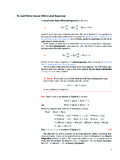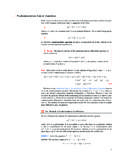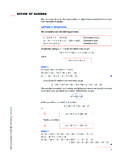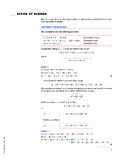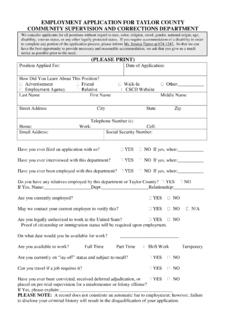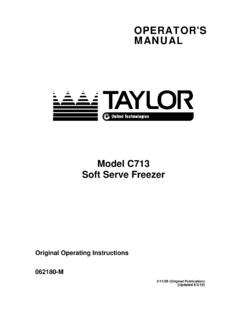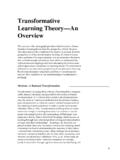Transcription of Formulas for the Remainder Term in Taylor Series
1 |||| Formulas for the Remainder Term in Taylor SeriesIn Section we considered functions with derivatives of all orders and their TaylorseriesThe th partial sum of this Taylor Series is the nth-degree Taylor polynomial offat a:We can writewhere is the remainderof the Taylor Series . We know that is equal to the sum ofits Taylor Series on the interval if we can show that we derive Formulas for the Remainder term . The first such formula involvesan is continuous on an open interval that contains , and is in , thenProofWe use mathematical induction. For ,and the integral in the theorem is . To evaluate this integral we integrateby parts with and , so and . Thus(by FTC 2)The theorem is therefore proved for .Now we suppose that Theorem 1 is true for , that is,We want to show that it s true for , that isRk 1 x 1 k 1 ! yxa x t k 1 f k 2 t dtn k 1Rk x 1k!
2 Yxa x t k f k 1 t dtn kn 1 f x f a f a x a R1 x 0 x a f a f x f a yxa x t f t dt x t f t t xt a yxa f t dtv f t du dtdv f t dtu x txxa x t f t dtR1 x f x T1 x f x f a f a x a n 1Rn x 1n! yxa x t nf n 1 t dtIxaIf n 1 1Rn x x a Rlimnl Rn x 0 x a RfRn x f x Tn x Rn x Tn x f a f a 1! x a f a 2! x a 2 f n a n! x a nn n 0 f n a n! x a nf12 Formulas FOR THE Remainder TERM IN Taylor SERIESA gain we use integration by parts, this time with and . Thenand , soTherefore, (1) is true for when it is true for . Thus, by mathematicalinduction, it is true for all .To illustrate Theorem 1 we use it to solve Example 4 in Section 1 Find the Maclaurin Series for and prove that it represents for all .SOLUTIONWe arrange our computation in two columns as follows:Since the derivatives repeat in a cycle of four, we can write the Maclaurin Series as follows:With in Theorem 1, we haveRn x 1n!
3 Yx0 x t n f n 1 t dta 0 x x33! x55! x77! n 0 1 n x2n 1 2n 1 !f 0 f 0 1! x f 0 2! x2 f 0 3! x3 f 4 x sin x f 4 0 0 f x cos x f 0 1 f x sin x f 0 0 f x cos x f 0 1 f x sin x f 0 0xsin xsin xnn kn k 1 f x Tk 1 x Rk 1 x f x Tk x f k 1 a k 1 ! x a k 1 f k 1 a k 1 ! x a k 1 Rk x 0 1 k 1 ! x a k 1 f k 1 a 1k! yxa x t k f k 1 t dt 1 k 1 ! x t k 1 f k 1 t t at x k 1 k 1 ! yxa x t k f k 1 t dt1 k 1 ! yxa x t k 1 f k 2 t dtv f k 1 t du k 1 x t k dtdv f k 2 t u x t k 1 Since is or , we know that for all . We use the fact(see Exercise 65 in Section ) that, for ,Thus, for ,For we can writesoThus, in any case, we haveThe right side of this inequality approaches 0 as (see Equation ), soby the Squeeze Theorem. It follows that as , so isequal to the sum of its Maclaurin some purposes the integral formula in Theorem 1 is awkward to work with, so weare going to establish another formula for the Remainder term.
4 To that end we need to provethe following generalization of the Mean Value Theorem for Integrals (see Section ).Weighted Mean Value Theorem for IntegralsIf and are continuous on anddoes not change sign in , then there exists a number in such thatProofBecause doesn t change sign, either or for . For thesake of definiteness, let s assume that .By the Extreme Value Theorem ( ), has an absolute minimum value and anabsolute maximum value , so for . Since , we havea x bmt x f x t x Mt x t x 0a x bm f x MMmft x 0a x bt x 0t x 0tyba f x t x dx f c yba t x dx a, b c a, b t a, b tf2sin xn l Rn x l 0 Rn x l 0n l Rn x x n 1 n 1 ! Rn x 1n! y0x x t n f n 1 t dt 1n! y0x t x n dt x n 1 n 1 !Rn x 1n! y0x x t n f n 1 t dtx 0 1n! yx0 x t n dt 1n! xn 1n 1 xn 1 n 1 ! Rn x 1n! yx0 x t n f n 1 t dt 1n! yx0 x t n f n 1 t dtx 0 yba f t dt yba f t dta bt f n 1 t 1 cos t sin tf n 1 t Formulas FOR THE Remainder TERM IN Taylor Series 3and soIf , these inequalities show that and so Theorem 2 istrue because both sides of the equation are 0.
5 If , it must be positive andwe can divide by in (3):Then, by the Intermediate Value Theorem ( ), there exists a number in suchthatand soTheoremIf is continuous on an open interval that contains , and is in , then there exists a number between and such thatProofThe function doesn t change sign in the interval from to , so theWeighted Mean Value Theorem for Integrals gives a number between and such thatThen, by Theorem 1,The formula for the Remainder term in Theorem 4 is called Lagrange s form of theremainder term. Notice that this expressionis very similar to the terms in the Taylor Series except that is evaluated at insteadof at . All we can say about the number is that it lies somewhere between and .In the following example we show how to use Lagrange s form of the Remainder termas an alternative to the integral form in Example n 1 Rn x f n 1 c n 1 !
6 X a n 1 1n! f n 1 c x a n 1n 1 f n 1 c n 1 ! x a n 1Rn x 1n! yxa x t n f n 1 t dt f n 1 c x t n 1n 1 t at x f n 1 c x a n 1n 1yxa x t n f n 1 t dt f n 1 c yxa x t n dtxacxat t x t nRn x f n 1 c n 1 ! x a n 1xacIxaIf n 1 4yba f x t x dx f c yba t x dxf c xba f x t x dxxba t x dx a, b cm xba f x t x dxxba t x dx Mxba t x dxxba t x dx 0xba f x t x dx 0xba t x dx 0m yba t x dx yba f x t x dx M yba t x dx34 Formulas FOR THE Remainder TERM IN Taylor SERIESEXAMPLE 2 Prove that Maclaurin Series for represents for all .SOLUTIONU sing the Lagrange form of the Remainder term with , we havewhere and lies between 0 and . But is or . In anycase, and soBy Equation the right side of this inequality approaches as , soby the Squeeze Theorem. It follows that as , so isequal to the sum of its Maclaurin 3(a) Approximate the function by a Taylor polynomial of degree 2 at.
7 (b) How accurate is this approximation when ?SOLUTION(a)Thus the second-degree Taylor polynomial isThe desired approximation is(b) Using the Lagrange form of the Remainder term we can writewhere lies between 8 and . In order to estimate the error we note that if ,then , so and therefore . Also, since ,we haveand soThus if , the approximation in part (a) is accurate to within x 9 R2 x 5 x 8 381c8 3 5 181 179 3 78 3 179x 7 x 8 3 1 x 8 1 1 x 8 17 x 9xcR2 x f c 3! x 8 3 1027c 8 3 x 8 33! 5 x 8 381c8 3s3x T2 x 2 112 x 8 1288 x 8 2 2 112 x 8 1288 x 8 2T2 x f 8 f 8 1! x 8 f 8 2! x 8 2 f x 1027x 8 3 f x 29x 5 3 f 8 1144 f x 13x 2 3 f 8 112 f x s3x x1 3 f 8 27 x 9a 8f x s3xsin xn l Rn x l 0 Rn x l 0n l 0 Rn x f n 1 c n 1 ! xn 1 x n 1 n 1 ! f n 1 c 1 cos c sin cf n 1 c xcf x sin xRn x f n 1 c n 1 ! xn 1a 0xsin xsin xFORMULAS FOR THE Remainder TERM IN Taylor Series 5




